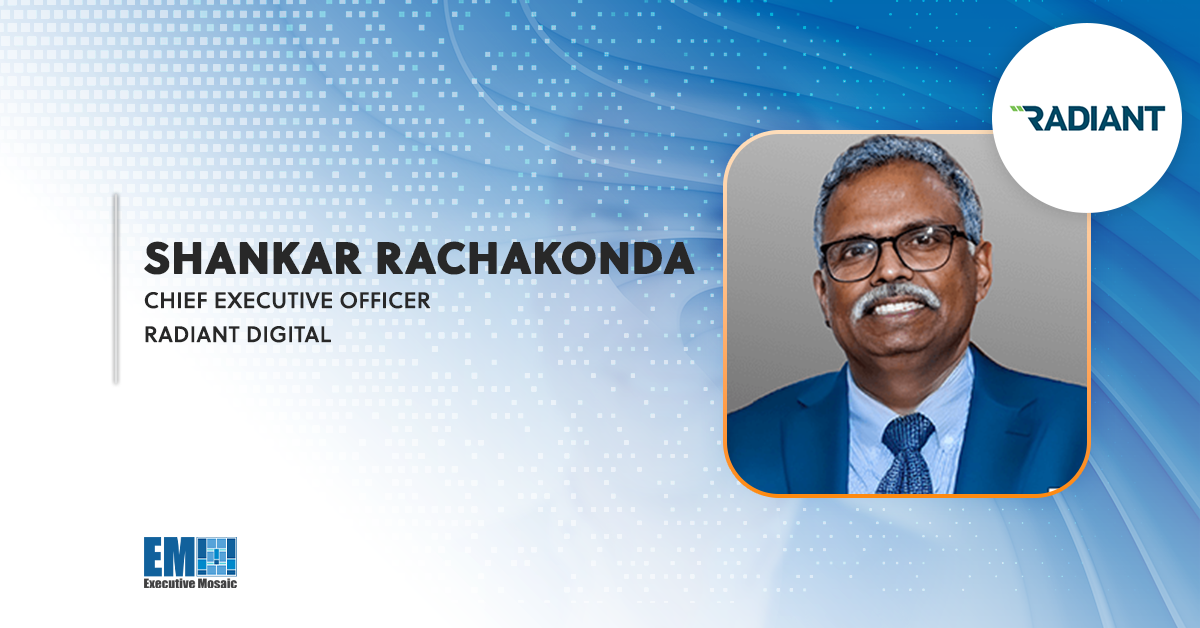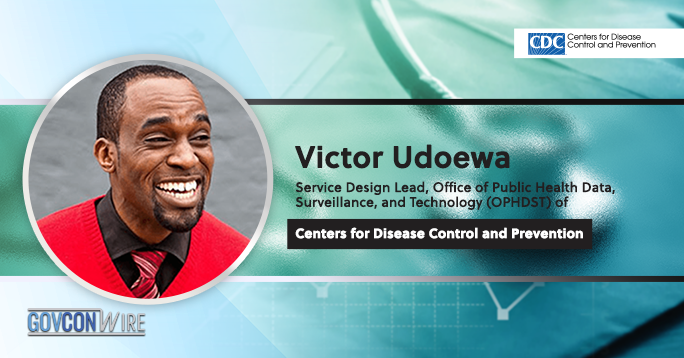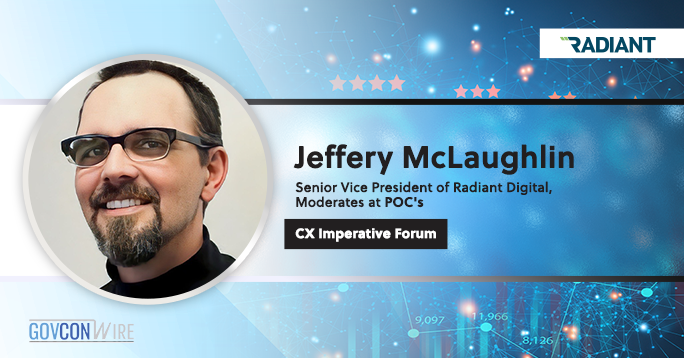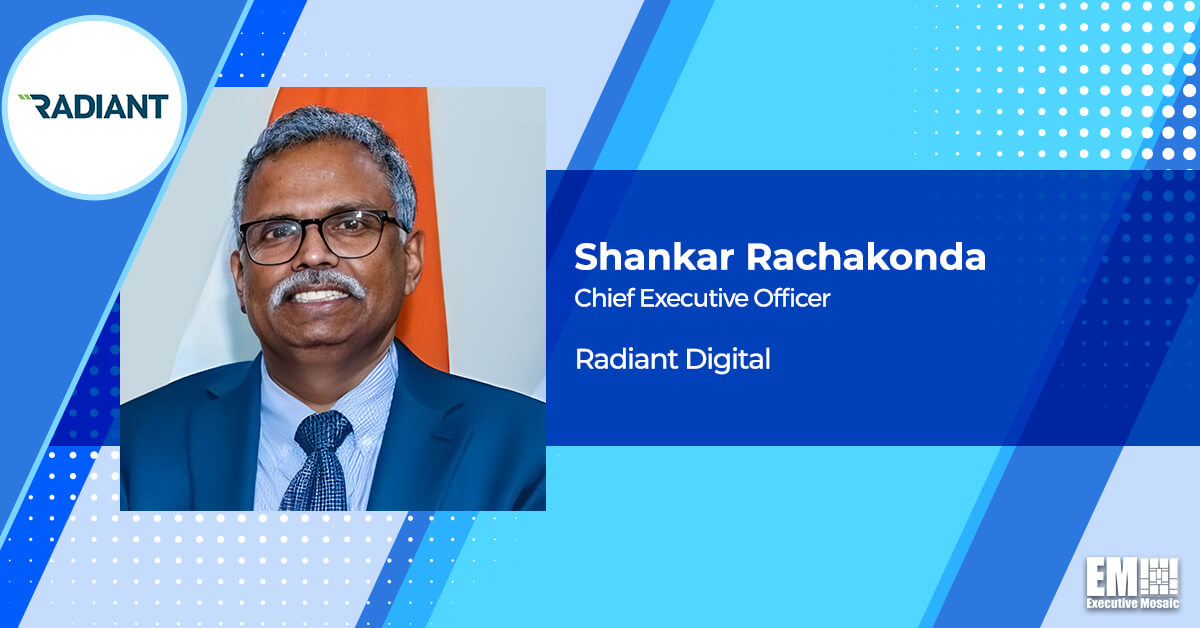Shankar Rachkonda has been an entrepreneur at heart for a long time, so it wasn’t a question if he was going to start a business, just a matter of when. After earning a mechanical engineering bachelor’s degree and a Ph.D. in engineering, he built a career working in large businesses serving government and commercial entities as a management consultant, holding positions like technical manager at Raytheon and principal consultant at PriceWaterhouseCoopers. He eventually took on a senior role so that he could gain a more thorough understanding of what it means to run an organization so that he might eventually start his own.
He broke off in 2000 to create information technology services SCI Group, the precursor to his current venture, Radiant Digital, which was birthed in 2015. Rachakonda is the company’s CEO and is in charge of spearheading its growth strategy. With Rachakonda at the helm, Radiant has made key acquisitions such as that of Singapore-based Compassites Technology Solutions and Florida-based Beacon Systems.
In this Executive Spotlight conversation, Rachakonda spoke with ExecutiveBiz about Radiant’s focus on digital transformation, its values of customer intimacy and competency and its mission to provide process-driven and tools-driven approaches.
Tell me about your company’s culture. What aspects of the company do you think are contributing most to its success while helping to attract and retain top-level talent?
The key aspects that influence our company culture are a set of core values. Let me talk about having the right attitude. We believe that anybody with the right attitude can conquer anything. It’s not always about the smarts, but how your attitude is focused on success. Secondly, we place a great importance on trust i.e. trusting each other. Thirdly, effectively communicating expectations is a really big part of our culture. When you have trust and this aspect of being able to communicate expectations, they reinforce each other. In turn, that really builds a very positive environment for effective communication between the company and the employees.
The other big aspects of our culture are accountability and self-management. Accountability is really about owning something—whether a success or failure—and just getting the job done. We are very big on self-management. We really would like for people to think in terms of their own priorities, be able to speak to others, get agreement and just get it done.
When you arrive at our company, within our culture, you should like what you do. You should like the people that you’re working with and you should like the money that you’re making—in that order. The fundamental thing is, you should really like what you do. Money is not the only thing. If you like what you do, then you automatically focus on building great relationships within the company, and then you focus on success. Success automatically helps you in terms of enhancing your situation with compensation.
Where are you seeing opportunities for expansion in your company’s portfolio? What new capabilities or markets are you eyeing?
In terms of Radiant Digital’s portfolio, big picture, we are focused on enabling digital transformation. Broadly, that has become a very big opportunity area for us, especially in the federal government sector because the federal government is now very much focused on digital transformation. Most federal agencies now have a transformation office, and these offices are responsible for those areas that are within the umbrella of digital transformation – the various aspects of it.
When you think in terms of transformation enablers, the federal government has been a leader, and they’re especially focusing on customer experience (in government parlance, it’s called citizen experience) and user experience . They want to lead with that, to the point where there is a presidential directive asking all agencies to make customer experience their centerpiece.
That has become a big opportunity for us at Radiant Digital to expand our portfolio. And the other area where we are seeing opportunity is large scale data management and leveraging data beyond analytics into artificial intelligence and machine learning. From the standpoint of emerging tech, this is of course a big thing, especially with AI. We are seeing opportunities there and we are positioning ourselves there, as well as under the umbrella of digital experience and the concepts of augmented reality and virtual reality.
We use VR technologies and integrate them into the overall customer experience, resulting in a holistic digital experience. What ends up happening is you start with that, and then you naturally expand into application development and other areas such as cloud enablement. This has become a big deal for us.
Another area where we are seeing a lot of opportunity and recent growth is in organizational transformation. That includes learning and development, change management and strategic communications.
We are focused on removing the mystery in these business areas and offering very systematic, process-driven and tools-driven approaches. Most of our capabilities are now solution-driven. Within CX and UX, we have something called the UX accelerator. It’s a collection of tools and techniques that will allow our customers to speedily implement enhanced CX and UX. That’s a new capability that we are very excited about.
Similarly, in the case of AI/ML and data management, there is large scale data management that is enabled by Data Ops and AI ops. That’s a set of new capabilities that we are specializing in. By way of supporting this Mixed Reality or Experience Reality—having a very strong posture with augmented reality and VR, putting it all together, and sort of dovetailing that with your regular, enterprise workflows, we are bringing real value to our customers.
We operate in all three major markets: federal government; state, local and education, or SLED; and commercial. We are looking at all three of these markets in pushing capabilities. Interestingly, in all three areas, especially lately with state governments, digital transformation has become big. You could call it modernization, but transformation is more aligned with business-focused thinking. It’s really about: how do you define your new strategic priorities to engage either your customers or your citizens effectively? How do you then leverage technology enable that? That’s transformation.
How do you set your priorities around limited capture dollars? What goes into the decision making process of what contracts you want to go after?
This is the million dollar question every GovCon CEO and business development executive faces. First, the question is how much to allocate. At Radiant, this decision is very much aligned with our growth plan and business plan because we know what lost revenue we have to replace and where we need to grow by adding revenue. Based on that, we weigh opportunities with sizing and our capture budget, and that sets up a priority. The name of the game is sustainment and growth. You’ve got to keep your current business and then you’ve got to add on top of that. Our business plan prioritizes capture budgets as well as priorities around those, a lot of them focused on, again, the right opportunity by way of size and in the right agencies or the right customers. That’s where our priorities lie.
In terms of decision-making, everybody cites probability to win or PWin. But the trick is trying not to drink the Kool-Aid that you can somehow enhance the PWin. The way the market is with competition everywhere, you see the lanes drawn very clearly as to who plays where. Understanding whether you are within a lane where you can succeed is the key and also dictates your assessment of PWin. That’s a big factor in decision-making, frankly. That’s what results in very highly qualified opportunities, and also helps us qualify our customers the right way. We do engage in some rapid responses when needed, but the focus is mostly on strategic opportunities that fit our qualifications.
That qualification process includes, most importantly, customer intimacy: is this within an agency where we know the customer and the customer trusts us? And of course, the competency fit. These two essentially allow you to describe yourself as a credible prime. Unless you can position yourself as a credible prime, we really don’t want to go after contracts.
All of these metrics — customer intimacy, competency, opportunity size — help us position ourselves as a credible prime. That is the most important thing!
Tell me about the current state of the artificial intelligence market. Where are you seeing new opportunities in AI, and where do you think the market is heading?
The AI market is quite obviously exploding right now, especially with the move into generative AI. These large language models have really changed the whole equation, especially with the way they’re implemented with neural nets or any of the more advanced AI models. The bottom line is, the game has shifted completely. There is a realization now that everybody has to look at this differently.
We see the market evolution in a couple of different ways. In terms of opportunities, needless to say, there are a lot in terms of automating tasks. Now we have Alexa and Siri on steroids. Anything that is conversation-oriented will be taken over by chatbots or AI bots and Radiant has a strong track record in this field. Then comes the aspect of what’s really changing the paradigm, which is what I call AI driven publication. Forget Chat GPT, we are all now able to see how well GPT-4 is able to produce content. We foresee a lot of opportunities with AI based content generation.
Whoever can really come up with a very quick way to understand customer requirements and produce lots of content that customers need has become very important. AI driven analytics is going to become very big, especially now that you can rely on your AI to understand your competition and markets by looking at data. To offer an interesting example, I read yesterday about a guy who used Chat GPT to pick the numbers that he wanted to use for a lottery. He didn’t win the big one, but he got close enough that he won a sum of some size.
The rate at which modern AI is able to learn is going to cause a whole new set of opportunities to emerge, where you AI specialized relative to markets or specific purposes. Much of this can be accomplished by writing a scaffolding on top of GPT-4, through simple programming to explain elegantly to GPT-4 as to what is needed.
At the end of the day, the answer depends on the question that you ask. The ability to translate a customer need and analytical need into something that the AI can easily understand and produce the right answer is going to be a big opportunity. In fact, that has now become the biggest opportunity area for individuals. People who are able to steward or essentially facilitate these conversations within companies to understand those analytical analysis requirements and then translate them into GPT-4 will be in big demand. They will get paid a lot of money.
Each market has different analytical needs. In health, it is understanding disease, in finance, it’s about money management. In oil and gas, perhaps it’s about exploration. In all these areas, you will see AI exploding and becoming the expert that tells you where to go and what to look for.
Then comes the so-called automation AI, which is automating real tasks. People are currently talking about robotic process automation. There is going to be a next level piece, because literally now we are talking about bot based tellers in the bank and so on and so forth, so that they can understand multiple pathways in terms of decision-making and thus automate much more complex tasks.
One other area we are particularly focusing on is large scale, industrial AI. We can all get excited about GPT-4, but unless you can align that into, again, a tools-driven approach and a process-driven approach, it’ll be a whole lot of excitement without big results. Industrial AI focuses on AI ops- and tools-driven environments where you integrate a systematic pipeline into everything and then let AI work, but then you have the levers in your hand, the control parameters through which you can essentially guide the AI in the right direction. That’s what industrial AI is all about. It’s a big opportunity area, and we believe the market is very much heading in that direction.







